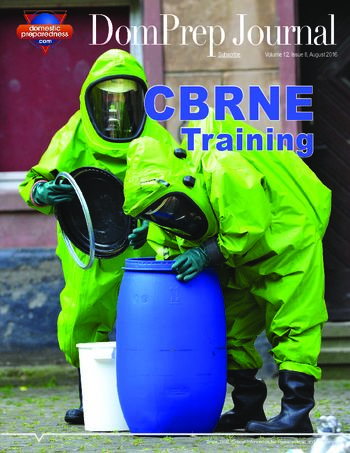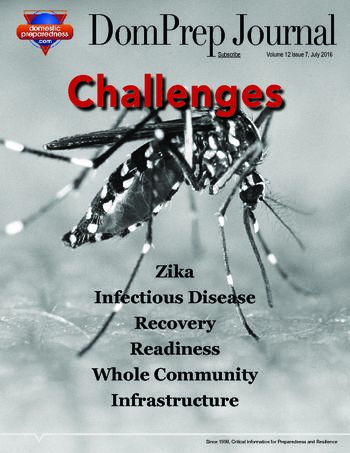
Author Archive

The CDC ensures the health, safety, and security of the American people. CDC scientists and public health experts are world leaders at responding to large-scale health emergencies such as natural disasters, pandemics, deliberate attacks, environmental catastrophes, and other health threats. http://www.cdc.gov/about/report/docs/2015healthsecurityreport18_508.pdf

UTMB Researchers Develop New Candidate Vaccines Against the Plague
Domestic Preparedness
October 20, 2016
(Released 10 October 2016) Galveston, TX – Researchers from The University of Texas Medical Branch at Galveston have developed new potential vaccines that protect animals against the bacteria that causes the deadly plague. These findings are detailed in NPJ Vaccines. The plague of Black Death infamy has had the power to strike fear in

Improving State Efforts to Prepare and Respond to Public Health Emergencies
Domestic Preparedness
October 17, 2016
Preparing for and responding to public health emergencies require involvement of the governor’s office – which coordinates and organizes the response – and multiple state agencies, such as public health, homeland security, and emergency management. This National Governors Association paper details actions governors can take to improve preparedness and response

Improved Procurement of Land Mobile Radios Could Enhance Interoperability and Cut Costs
Domestic Preparedness
October 15, 2016
Federal agencies, which the U.S. Government Accountability Office (GAO) surveyed, generally use land mobile radio (LMR) equipment to meet their core missions, such as public safety, emergency management, or firefighting. In this report, GAO examined federal agencies’ LMR interoperability and procurement practices. http://www.gao.gov/assets/690/680331.pdf

Mass Casualty Decontamination Guidance and Psychosocial Aspects of CBRN Incident Management: A Review and Synthesis
Domestic Preparedness
October 3, 2016
Mass casualty decontamination is an intervention employed by first responders at the scene of an incident involving noxious contaminants. This report reviews decontamination guidance for emergency responders and associated research evidence, in order to establish the extent to which psychosocial aspects of casualty management have been considered within these documents.

CBRNE Threats
Domestic Preparedness
September 28, 2016
Featured in this issue: Addressing Threats From Concept to Field, By Catherine L. Feinman; The Danger of Not Keeping Up With Technological Advances, By Melissa Moses; Technology for Improved Public Health Preparedness & Response, By Greg Burel; Hazard Detection: Bring Your Own Protection, By Kathryn Laskey; A Conversation That Should

Sea-Level Rise and US Coasts: Science and Policy Considerations
Domestic Preparedness
September 23, 2016
Policymakers are interested in sea-level rise because of the risk to coastal populations and infrastructure and the consequences for coastal species and ecosystems. This report describes the phenomenon of sea-level rise, the types of effects that sea-level rise can have on U.S. coasts, and provides a primer on policy considerations.

Disinfection of Biological Agents in the Field Using a Mobile Advanced Oxidation Process
Domestic Preparedness
September 16, 2016
The Office of Research and Development’s National Homeland Security Research Center (NHSRC), part of the U.S. Environmental Protection Agency (EPA), published a new study of biological agent disinfection in the field using a mobile advanced oxidation process. https://cfpub.epa.gov/si/si_public_record_report.cfm?dirEntryId=326651

CBRNE Training
Domestic Preparedness
August 31, 2016
Featured in this issue: The Things That Keep Experts Up at Night, By Catherine Feinman; How to Address the Human Side of Critical Incidents, By George S. Everly Jr.; Plugging the Experience Drain in Hazmat Response, By Christopher Wrenn; Innovative Approaches to Radiological/Nuclear Preparedness, By Erin Mohres & Darren Chen;

Challenges
Domestic Preparedness
July 27, 2016
Featured in this issue: Public Health – Opportunities for Action, By Catherine L. Feinman; Bringing Public Health Preparedness Into the 21st Century, By Emily Lord; Threats Evolving Faster Than Preparedness, By Robert C. Hutchinson; Social Impact Bonds & Sustainable Disaster Risk Reduction, By Justin Snair & Megan Reeve Snair; Public
Follow Us
Get Instant Access
Subscribe today to Domestic Preparedness and get real-world insights for safer communities.
ARchives
Follow Us
Get Instant Access
Subscribe today to Domestic Preparedness and get real-world insights for safer communities.


